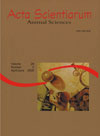<b>Propolis hidroalcoholic extract effect on performance and composition leucocytary of the blood bullfrog tadpoles (<em>Rana catesbeiana</em>)</b> - DOI: 10.4025/actascianimsci.v29i2.240
Abstract
The effect of the propolis hidroalcoholic extract was evaluated on the performance of bullfrog tadpoles. 1,400 tadpoles were used, distributed in twenty experimental tanks with 70 liters of water, in the density of one tadpole per liter. The different levels of propolis (0.0; 0.2; 0.5; 1.0 and 1.5%) were mixed with commercial ration (45% CP). The feeding was four times a day. In the end of the experiment, the blood was collected from the vase flow, in five tadpoles of each repetition. The differential counting of leucocytes was accomplished in red-faced extensions by the method of Rosenfeld (1947), in light microscope. The different levels of propolis hidroalcoholic extract did not influence the survival, consumption, feed conversion and length. Yet the weight gain suffered influence (p < 0.05) - it was observed a smaller weight gain in the tadpoles that did not receive propolis hidroalcoholic extract. The metamorphosis was more accelerated when they received propolis hidroalcoholic extract in their diet. The leucocytary group influenced by the propolis (p < 0.05) were the monocytes, which in the doses of 0.2 and 0.5%, presented largest percentage, differing from the control group and from the dose of 1.5%. The lymphocytes, basophil, neutrophil, eosinophil did not present statistical difference among the treatments.Downloads
Download data is not yet available.
Published
2007-11-13
How to Cite
Arauco, L. R. R., Stéfani, M. V. de, & Nakaghi, L. S. O. (2007). <b>Propolis hidroalcoholic extract effect on performance and composition leucocytary of the blood bullfrog tadpoles (<em>Rana catesbeiana</em>)</b> - DOI: 10.4025/actascianimsci.v29i2.240. Acta Scientiarum. Animal Sciences, 29(2), 227-234. https://doi.org/10.4025/actascianimsci.v29i2.240
Issue
Section
Animal Production
DECLARATION OF ORIGINALITY AND COPYRIGHTS
- I Declare that current article is original and has not been submitted for publication, in part or in whole, to any other national or international journal.
The copyrights belong exclusively to the authors. Published content is licensed under Creative Commons Attribution 4.0 (CC BY 4.0) guidelines, which allows sharing (copy and distribution of the material in any medium or format) and adaptation (remix, transform, and build upon the material) for any purpose, even commercially, under the terms of attribution.
Read this link for further information on how to use CC BY 4.0 properly.
0.9
2019CiteScore
29th percentile
Powered by 








































